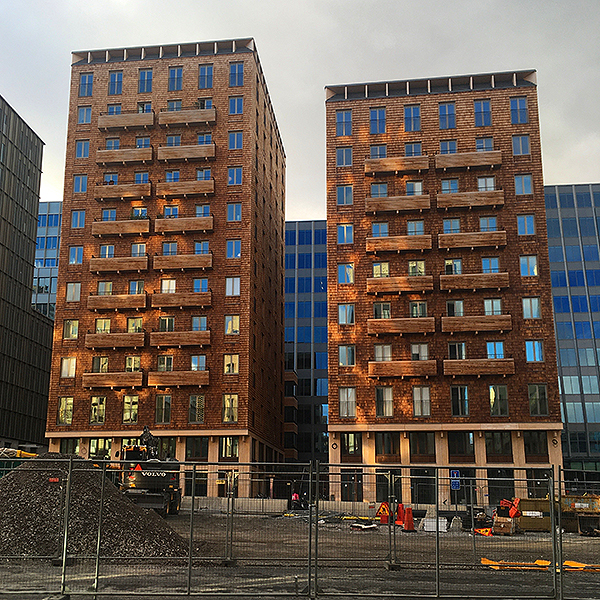Substituting concrete with wood in multi-family housing construction will benefit the climate as long as our living area does not increase. Cross-laminated timber frame enables taller buildings but also requires more wood. Together with a larger living area, such an increase in wood demand would remove the climate benefits of switching from concrete to wood. A new study shows that the most climate-smart solution would be smaller living areas combined with timber light-frame construction.
The demand for additional construction in multi-family housing in Sweden is projected to be 46 000 dwellings per year from today until 2030 and 57 000 per year from 2030 until 2070, based on the Swedish National Board of Housing, Building and Planning (Boverket) and Statistics Sweden (SCB). This provides an opportunity to substitute emission-intensive concrete with wood, which can contribute to reach the Swedish target of becoming greenhouse gas emission neutral by 2045.
It is not only the choice of material, wood over concrete, that matters to reduce the climate impact but also the amount of material we produce and use.
Little additional harvest needed
The current standard in Sweden for wood construction is timber light frame. However, timber light frame can only be used for a limited height in multi-story buildings. For taller multi-story buildings, which are frequently used in multi-family housing construction, the more wood-intensive cross-laminated timber can be used. The researchers considered what would happen if the additional wood for replacing concrete frame - by either timber light frame or cross-laminated timber frame - was exclusively sourced from Swedish forests. This assumption was made to minimize possible carbon leakage from wood imports. To assess the effect of different harvest levels on the forest, six different wood demand scenarios were simulated in Heureka, covering decreased, stable and increased sizes of living area combined with the two timber frame systems, timber light frame and cross-laminated timber.
The results show that the increase in forest harvest to replace concrete frame in multi-family housing construction would be remarkably small.
Depending on which timber frame system we choose for the replacement, only 0.7% to 1.6% additional harvest per year would be required compared to the average annual Swedish sawlog harvest volume during 2016–2020, according to the study.
Living areas must not increase
The relatively small additional harvest volume required is given if the future living area stays the same or decreases. However, research shows that the average living area per person has increased over the past decades in Sweden and globally. A continuation of this trend, combined with using cross-laminated timber frame in multi-family housing would lead to losing the climate benefit of substituting concrete with wood.
Using cross-laminated timber in multi-family housing construction would lead to a larger loss of old forest area in Sweden since it requires more wood per m² of living area compared to the timber frame mix used in the country today. However, there are other advantages to consider for cross-laminated timber. In particular, it enables the construction of higher buildings, which – in comparison to constructing smaller timber light frame buildings - can reduce the area of land sealing, which allows us to keep more green spaces.
In conclusion, the most climate-smart solution would be to base the future Swedish multi-family housing construction on using the currently dominating timber light frame combined with smaller living areas.

